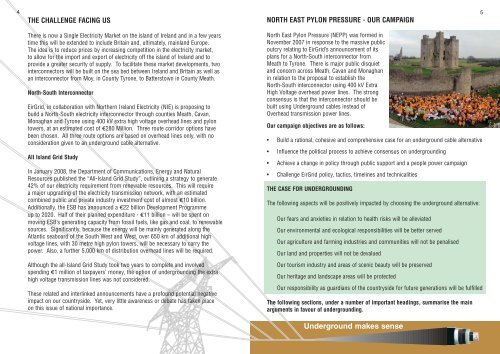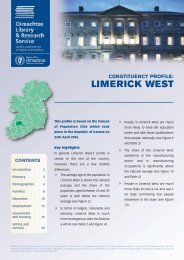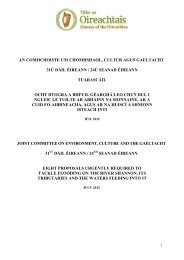north east pylon pressure
north east pylon pressure
north east pylon pressure
Create successful ePaper yourself
Turn your PDF publications into a flip-book with our unique Google optimized e-Paper software.
4<br />
THE CHALLENGE FACING US<br />
There is now a Single Electricity Market on the island of Ireland and in a few years<br />
time this will be extended to include Britain and, ultimately, mainland Europe.<br />
The idea is to reduce prices by increasing competition in the electricity market,<br />
to allow for the import and export of electricity off the island of Ireland and to<br />
provide a greater security of supply. To facilitate these market developments, two<br />
interconnectors will be built on the sea bed between Ireland and Britain as well as<br />
an interconnector from Moy, in County Tyrone, to Batterstown in County Meath.<br />
North-South Interconnector<br />
EirGrid, in collaboration with Northern Ireland Electricity (NIE) is proposing to<br />
build a North-South electricity interconnector through counties Meath, Cavan,<br />
Monaghan and Tyrone using 400 kV extra high voltage overhead lines and <strong>pylon</strong><br />
towers, at an estimated cost of €280 Million. Three route corridor options have<br />
been chosen. All three route options are based on overhead lines only, with no<br />
consideration given to an underground cable alternative.<br />
All Island Grid Study<br />
In January 2008, the Department of Communications, Energy and Natural<br />
Resources published the “All-Island Grid Study”, outlining a strategy to generate<br />
42% of our electricity requirement from renewable resources. This will require<br />
a major upgrading of the electricity transmission network, with an estimated<br />
combined public and private industry investment cost of almost €10 billion.<br />
Additionally, the ESB has announced a €22 billion Development Programme<br />
up to 2020. Half of their planned expenditure - €11 billion – will be spent on<br />
moving ESB’s generating capacity from fossil fuels, like gas and coal, to renewable<br />
sources. Significantly, because the energy will be mainly generated along the<br />
Atlantic seaboard of the South West and West, over 650 km of additional high<br />
voltage lines, with 30 metre high <strong>pylon</strong> towers, will be necessary to carry the<br />
power. Also, a further 5,000 km of distribution overhead lines will be required.<br />
Although the all-Island Grid Study took two years to complete and involved<br />
spending €1 million of taxpayers’ money, the option of undergrounding the extra<br />
high voltage transmission lines was not considered.<br />
These related and interlinked announcements have a profound potential negative<br />
impact on our countryside. Yet, very little awareness or debate has taken place<br />
on this issue of national importance.<br />
NORTH EAST PYLON PRESSURE - OUR CAMPAIGN<br />
North East Pylon Pressure (NEPP) was formed in<br />
November 2007 in response to the massive public<br />
outcry relating to EirGrid’s announcement of its<br />
plans for a North-South interconnector from<br />
Meath to Tyrone. There is major public disquiet<br />
and concern across Meath, Cavan and Monaghan<br />
in relation to the proposal to establish the<br />
North-South interconnector using 400 kV Extra<br />
High Voltage overhead power lines. The strong<br />
consensus is that the interconnector should be<br />
built using Underground cables instead of<br />
Overhead transmission power lines.<br />
Our campaign objectives are as follows:<br />
• Build a rational, cohesive and comprehensive case for an underground cable alternative<br />
• Influence the political process to achieve consensus on undergrounding<br />
• Achieve a change in policy through public support and a people power campaign<br />
• Challenge EirGrid policy, tactics, timelines and technicalities<br />
THE CASE FOR UNDERGROUNDING<br />
The following aspects will be positively impacted by choosing the underground alternative:<br />
Our fears and anxieties in relation to health risks will be alleviated<br />
Our environmental and ecological responsibilities will be better served<br />
Our agriculture and farming industries and communities will not be penalised<br />
Our land and properties will not be devalued<br />
Our tourism industry and areas of scenic beauty will be preserved<br />
Our heritage and landscape areas will be protected<br />
Our responsibility as guardians of the countryside for future generations will be fulfilled<br />
The following sections, under a number of important headings, summarise the main<br />
arguments in favour of undergrounding.<br />
Underground makes sense<br />
5

















